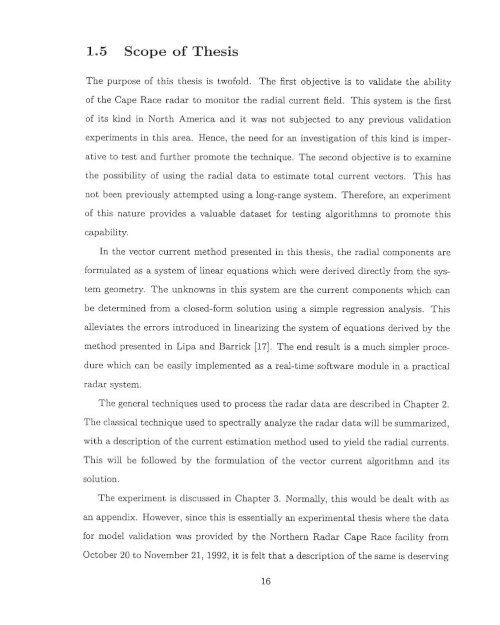total of 10 pages only may be xeroxed - Memorial University's Digital ...
total of 10 pages only may be xeroxed - Memorial University's Digital ...
total of 10 pages only may be xeroxed - Memorial University's Digital ...
You also want an ePaper? Increase the reach of your titles
YUMPU automatically turns print PDFs into web optimized ePapers that Google loves.
1.5 Scope <strong>of</strong> Thesis<br />
The purpme <strong>of</strong> this thesis is tw<strong>of</strong>old. The &-st objectwe is to validate the ability<br />
<strong>of</strong> the Cape Rae radar to monitor the radial current 6eld. This system is the &st<br />
<strong>of</strong> its kind in North America and it was not svbjsted to any previom validation<br />
experiments in this area. Hence, the need for an investiffatin <strong>of</strong> this kind is imper-<br />
ative to test and further promote the technique. The second objective is to examine<br />
the passihility <strong>of</strong> using the radial data to estimate <strong>total</strong> nurent vectors. This has<br />
not <strong>be</strong>en prwiously attempted using a long-range -em. Therefore, an experiment<br />
<strong>of</strong> this nature pmvide. a valuable dataset for testing algorithmme to promote this<br />
capability.<br />
In the -tor current method presented in this thesis, the radial components are<br />
formulated as a system <strong>of</strong> linear equations which were derived directly from the<br />
tem geometry. The u n l m in ~ this system are the current components which can<br />
<strong>be</strong> determined from a closed-form solution using a simple re-on analysis. This<br />
alleviates the errors introduced in linearizing the system <strong>of</strong> equations derived by the<br />
method presented in Lipa and Barrick [17]. The end result is a much simpler proea<br />
dure which can <strong>be</strong> esrily implemented as a real-time s<strong>of</strong>tware module in a practical<br />
radar sptem.<br />
The general techaiques used to pro- the radar data are d-i<strong>be</strong>d in Chapter 2.<br />
The elanrid technique used to spectrally analyze the radar data will <strong>be</strong> summarized,<br />
with a description <strong>of</strong> the current estimation method med to yield the radial nurents.<br />
This will <strong>be</strong> followed by the formulation <strong>of</strong> the vector current aigarithmn and its<br />
soiution.<br />
The experiment is discussed in Chapter 3. Normally, this would <strong>be</strong> dealt with as<br />
an appendix. H-wr, since this is essentially an experimental thesis where the data<br />
for mod4 validation was provided by the Northern Radar Cape Race facility from<br />
Octo<strong>be</strong>r 20 to Novem<strong>be</strong>r 21, 1992, it is felt that a description <strong>of</strong> the same is deserving<br />
16

















